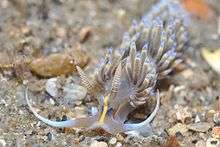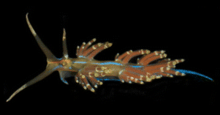Dondice occidentalis
| Dondice occidentalis | |
|---|---|
 | |
| A live individual of Dondice occidentalis | |
| Scientific classification | |
| Kingdom: | Animalia |
| Phylum: | Mollusca |
| Class: | Gastropoda |
| (unranked): | clade Heterobranchia clade Euthyneura |
| Superfamily: | Aeolidioidea |
| Family: | Facelinidae |
| Subfamily: | Favorininae |
| Genus: | Dondice |
| Species: | D. occidentalis |
| Binomial name | |
| Dondice occidentalis Engel, 1925 | |
Dondice occidentalis is a species of sea slug, an aolid nudibranch, a marine gastropod mollusk in the family Facelinidae.[1]
Taxonomy
According to Gonzalez et al. (2013),[2] Dondice occidentalis and Dondice parguerensis probably represent an example of incipient sympatric speciation.[3] Molecular analyses support partially the differentiation of these species, but are inconclusive.[3] Further research is needed in order to resolve this species complex.[3]
Distribution
Distribution of Dondice occidentalis includes Florida, Mexico, Belize, Costa Rica, Colombia, Venezuela, Curaçao, Bonaire, Venezuela, Bermudas, Bahamas, Cayman Islands, Jamaica, Turks and Caicos, Grenada, Sint Maarten, Martinique, Trinidad, Brazil and Panama.[3]
Description

The body is elongate, tapering toward the posterior end.[3] Rhinophores are annulate and long.[3] Oral tentacles are longer than the rhinophores.[3] Cerata are arranged in clusters along two rows on the dorsum.[3] Background color is translucent gray with a yellow or orange median line of variable width, running from the head to the anterior end, between the rhinophores.[3] There is sometimes present a white or blue broken line down the dorsal mid-line from behind the rhinophores to the posterior end of the body.[3] Opaque white spots are sometimes present on the dorsum.[3] Oral tentacles are translucent or light blue at the base, becoming white towards the tips.[3] Cerata are translucent gray, often with large blue or white bands covering the upper two-thirds of each ceras.[3] The maximum recorded body length is 50 mm.[3][4]
Habitat
The minimum recorded depth is 0 metres.[4] The maximum recorded depth is 26 metres.[4]
It was found on hydroids in Panama.[3] This species feeds on hydroids of the genus Eudendrium and Amathia.[3]
It easily sheds the cerata when it is disturbed.[3]
References
This article incorporates Creative Commons (CC-BY-4.0) text from the reference[3]
- ↑ Gofas S. (2005). Dondice occidentalis Engel, 1925. In: MolluscaBase (2016). Accessed through: World Register of Marine Species at http://www.marinespecies.org/aphia.php?p=taxdetails&id=181246 on 2016-10-26
- ↑ Gonzalez L., Hanson D. & Valdés Á. (2013). "Molecular divergence between two sympatric species of Dondice (Mollusca: Nudibranchia) with distinct feeding specializations". Journal of the Marine Biological Association of the United Kingdom 93(7): 1887-1893. doi:10.1017/S0025315413000465.
- 1 2 3 4 5 6 7 8 9 10 11 12 13 14 15 16 17 18 Goodheart J. A., Ellingson R. A., Vital X. G., Galvão Filho H. C., McCarthy J. B., Medrano S. M., Bhave V. J., García-Méndez K., Jiménez L. M., López G. & Hoover C. A. (2016). "Identification guide to the heterobranch sea slugs (Mollusca: Gastropoda) from Bocas del Toro, Panama". Marine Biodiversity Records 9(1): 56. doi:10.1186/s41200-016-0048-z
- 1 2 3 Welch J. J. (2010). "The “Island Rule” and Deep-Sea Gastropods: Re-Examining the Evidence". PLoS ONE 5(1): e8776. doi:10.1371/journal.pone.0008776.